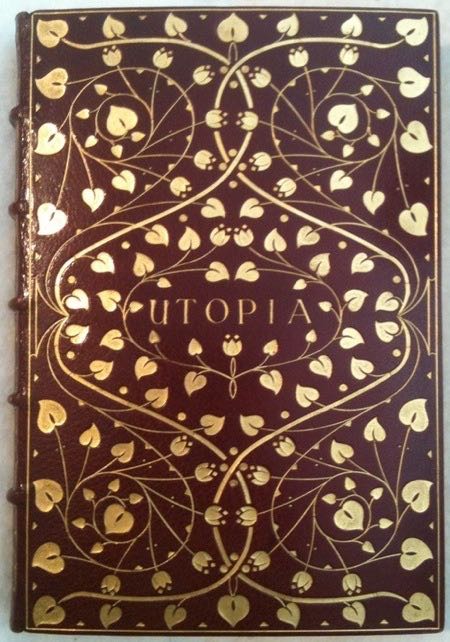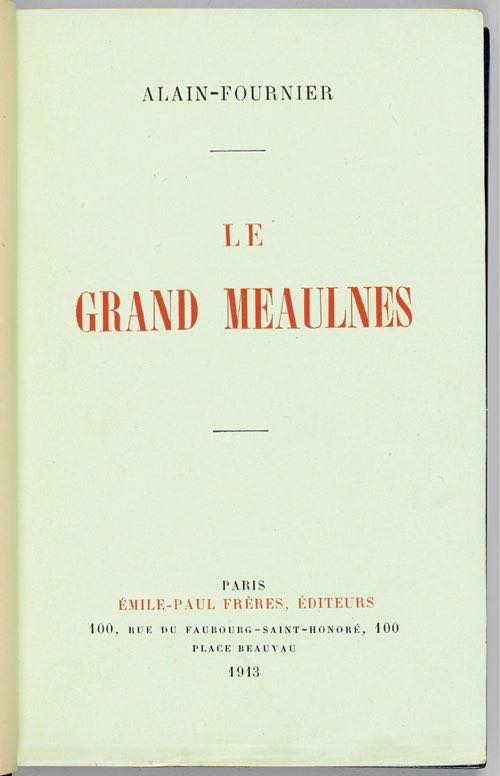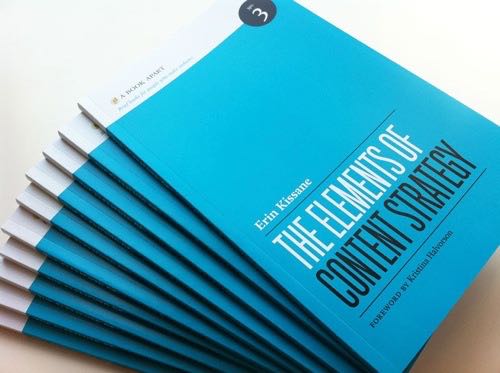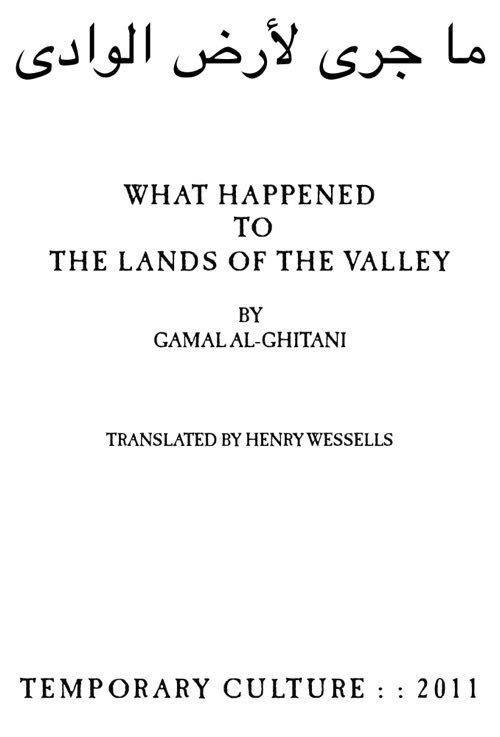
January to March 2011

27-28 March 2011
During a recent trip to Texas, I visited several wonderful libraries (private and institutional), saw friends, and admired some of the private press treasures of the Bridwell Library in Dallas, including William Morris’ manuscript library list (compiled by him and his daughter, 1890-1891, and later bound by Katharine Adams), and the copy of the monumental Kelmscott Chaucer printed on vellum and inscribed “ To Ed Burne-Jones William Morris Sept. 1896 ” (shortly before Morris died). The picture above is of the Bridwell library copy of the Kelmscott Press Utopia (1893), in a beautiful red binding by the Doves bindery, 1894.
This is the view from the window of another library :
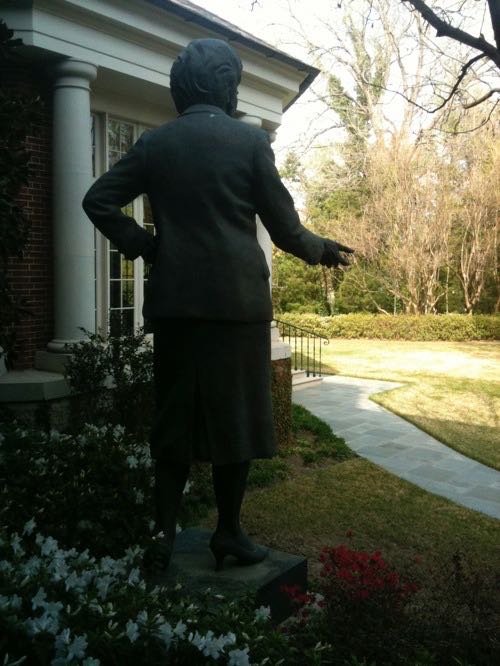
The backside of Mrs. Thatcher. The pedestal reads “ It should have been made of iron. ”
The view from the terrace outside another library :
While in Austin, your correspondent met with Don Webb, author of When They Came (Temporary Culture, 2006), over a pleasant breakfast. Your correspondent ate grits and fried eggs (see also below) :
— Thomas M. Disch. The Businessman. A Tale of Terror [1984.]
Foreword by John Crowley [ “ Thomas M. Disch and the
Will of Heaven ” ]. Supernatural Minnesota 1. University
of Minnesota Press, [2010]. xx, 292 pp.
— — The M.D. A Horrror Story [1991.]
Foreword by John Clute. Supernatural Minnesota 2. University of Minnesota Press,
[2010]. xix, 401 pp.
— — The Priest. A Gothic Romance [1994.]
Foreword by Gregory Feeley. Supernatural Minnesota 3. University of Minnesota
Press, [2010]. xxv, 303 pp.
— — The Sub. A Tale of Witchcraft [1999.]
Foreword by Elizabeth Hand. Supernatural Minnesota 4. University of Minnesota
Press, [2010]. xv, 285 pp.
These four novels by Thomas M. Disch, newly re-issued by the University of Minnesota Press in a uniform edition, comprise a close examination of the American condition at the end of the twentieth century that is unequalled in its dark insight, sharp wit, and perfectly shaped prose. The re-issue is also notable as the commissioned forewords represent the first substantial posthumous assessment of Disch’s literary work (as distinct from the memorials and biographical notes written in the aftermath of his death in 2008). Disch was always an acute observer of the American Midwest (as, for example, in the first half of On Wings of Song ). These four novels adopt many of the concerns of the horror and fantastical modes while being firmly rooted in the geography and psychology of the Midwest. John Crowley identifies paradoxes inherent in The Businessman , “ one of the oddest, funniest, most coldly nasty and sweetly comic ghost stories in the American canon ” :
. . . like all novelists, Disch knew very well that the laws of cause and effect, no matter how conceived and presented, whether they are the ones familiar to us and left unspoken in a novel Or ones (like Disch’s) invented for the occasion, actually work opposite to the way they do in life. Instead of causes bringing about effects, in novels it is the effects — those things that the novelist wants to have happen, the marriages or deaths, successes or chance meetings — that bring about their causes.
Crowley notes that the novel has “ something like the sweet impossibility of the closure of a Mozart opera or a Shakespeare comedy. ” This contrasts with the usual practice of the horror mode, where there is a revelation of stark, unbearable facts about the nature of the world. that in comedy, “ according to [Northrop] Frye, we are impressed with the illusion of reality : this is the sort of thing that just doesn’t happen and yet here it is before us, happening. That, I think, is the effect of Disch’s nervy and unnerving presumption in The Businessman that excludes it from the realm of horror — though the whole series of Supernatural Minnesota may indeed tell a worse story, or a worse world. ” He also draws attention to something that holds true in all four of the novels. “ Phrases, metaphors, insights just too good for the context or the genre, dispensed generously. ” Disch really does excel at the gnomic present, the Olympian diction, and the sparkling phrase straight from the American Parnassus.
The M.D. is the widest in scope of the novels, and in many ways the most appalling (though each of the principal characters of the novels is as monstrous as the next). The novel charts the career of William (Billy) Michaels, who as a child gains the power to heal from a demons in the form of the god Mercury, but only to the extent that he inflicts a similar degree of harm. John Clute notes that “ The M.D. proved to be the longest novel Thomas M. Disch was ever to write. [. . .] Rather oddly, perhaps, for a pact-with-the-devil tale that offers absolutely no hope for a happy ending, The M.D. is the warmest story Disch ever wrote. ” Billy Michaels grows up to be a doctor and investment wizard and “ a successful monster ” in Clute’s felicitous coinage, who grows powerful as he is able to cure AIDS and hold out the prospect of a cure for an even more devastating plague that Disch has unleashed upon America. He embarks upon a plan to turn a rural county in Minnesota into a medical concentration camp for plague victims before events move beyond his ability to control them: “ he never understands that to worship crocodiles is to be eaten by crocodiles. ” Clute traces Disch’s long-standing interest in Thomas Mann and writes :
Disch’s central turn from a book like Buddenbrooks is that The M.D. is a bildungsroman whose protagonist learns nothing. It is here the post-Mann ironic voice of his deepest and longest novel most profoundly addresses the human condition in our times — in its refusal of any hope that it may benefit the potential learner at its heart to learn more. William Michaels learns only that he is turning to ash, and so it is with the America he so clearly manifests, the America he has been burning to the ground. ”
Gregory Feeley, in his foreword to The Priest , writes, “ Rereading Disch’s profoundly dark satire after fifteen years, one notices how his targets are still very much with us [. . . ] but also how deeply it engages less topical themes, specifically that of authority. Predatory clerics and those who protect them abuse their already considerable power, but Disch’s unsparing survey of the exercise of authority and the varieties of resistance (and surrender) to it extends beyond the operations of formal hierarchies. The Church (in Disch’s novel and elsewhere) may be a rigidly top-down structure, but power and authority are distributed through what Jacques Lacan calls ‘ the symbolic order ’ in a complex and sometimes perverse manner, which Disch exploits with both a moralist’s umbrage and a novelist’s zeal.” Feeley cites a passage by James Blish concerning the significance of tattoos, that they “ come into being to identify the self to the self ” as one possible tributary stream that fed a central image in this novel, the tattoo of Satan visible only to Father Bryce and to those characters who are figments of his imagination. He also observes that “ The Priest may be a satire (to a degree), a Gothic, and a Romance, but like all Disch’s novels it is also a family saga [. . .] Families in Disch’s novels are always breaking apart [. . .] ”. The Priest is a gothic romance in the strict, original sense of the term : a world and its inhabitants (including innocents and depraved priests) haunted, driven by unspeakable urges made manifest. Like the castles of the eighteenth century gothic novels, The Priest includes one of the most remarkable works of Midwestern architecture in Disch’s writings, the Shrine of the Blessed Konrad of Paderborn :
In the heyday of The Ave Maria Hour , from 1949 to 1958, the threat of Communism had been taken seriously, and the Shrine — with its enormous ferroconcrete dome (the fifth largest in the nation) and its immense subterranean complex of crypts, chapels, catacombs, and nuclear contingency command centers — was arguably the most imposing nonmilitary monument of the Cold War.
In the novel, the colossal building has been repurposed as the secret headquarters for a group of anti-abortion militants who imprison women during the term of their pregnancy.
In her forward to The Sub , Liz Hand describes the carefully narrated dysfunctionality of Leech Lake : “ one has the feeling of a newcomer being driven around a small town by a loquacious host who cheerfully points out the homes of the town drunk, slut, wife beater, and so on. [. . .] Disch revels in being an equal opportunity misanthrope. ” In Disch’s work, words are artefacts of power : the rhyming invocations of Billy Michaels are central to The M.D. , and so too for Diana Turney of The Sub , whose witchcraft emerges in lies and recovered memories of childhood abuse. Diana’s “ transformation into a modern-day Circe is as down-to-earth as the beauty parlor visit that leaves her newly blonde and glamorous, irresistible to the men (and women) she enslaves. ” Hand notes the classical roots of Diana’s first exercise of her powers, “ a reenactment of the fate of Actaeon … turned into a stag by the goddess and then torn apart by his own hounds. ” Late in the novel, Disch alludes to Shelley’s equation of the sin of Prometheus with flesh-eating : “ We live by eating other living things, and all our heirs are born to follow us (if not precede us) to death. That is the meaning of original sin. ” Both The M.D. and The Sub conclude with images of the heirs to Diana’s and Billy’s powers about to set foot on a well-worn path.
Clute, Crowley, Feeley, and Hand all knew Disch, and there are interesting glimpses of personal reminiscence in these forewords, but the real focus is on the texts of these novels. Your correspondent also knew Tom Disch, in the last two-and-a-half years of his life, and if there is one thing of which he was unwaveringly certain, it was his enduring place in American letters. On Wings of Song and Camp Concentration have never been neglected ; the Supernatural Minnesota re-issue is a welcome first step toward bringing his major work before a new audience.
Recent reading :
— Michael Swanwick. Dancing with Bears. The Postutopian Adventures of Darger & Surplus. Night Shade Books, [forthcoming, May 2011]. For a review for the New York Review of Science Fiction .
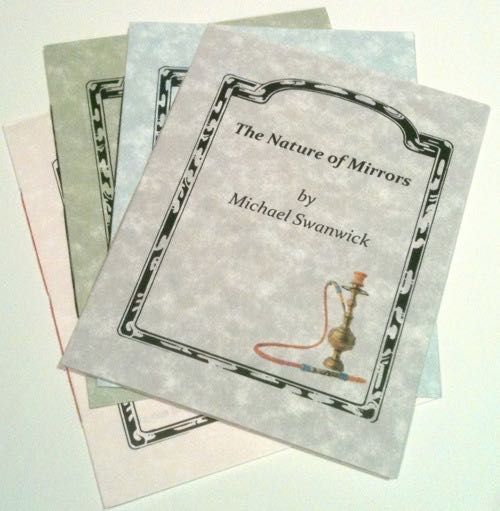
— Michael Swanwick. American Cigarettes [and] Song
of the Lorelei [and] The Brain-Baron [and] The
Nature of Mirrors . [4], [4], [6], [6] pp. 4 vols., [Philadelphia
: Dragonstairs Press, 2011]. Printed self-wrappers, sewn. Each title
no. 50 of 100 copies signed by the author. Originally published in
different form in Live without a Net , ed. Lou Anders
(2003). Compliments of the publisher.
Four incidents from the central European travels of those enterprising scoundrels
Darger and Surplus, witty turns that instil in the reader a curious nostalgia
for the future. Michael Swanwick has a Note about
nano publisher Dragonstairs Press.
— — — —
— H. Alain-Fournier. Le Grand Meaulnes , 1913. A classic novel, and somehow one that I escaped from French lycée without ever having read (until now). A beautiful story, mysterious at times, and finally, a tragic one, sadder even than The Good Soldier (1915) because so compressed and so closely tied to fleeting youth. There are superb scenes of late summer parties that seem to have echoed through twentieth century literature. The novel is a story of adolescent obsession upon an ideal, and the lasting consequences of Meaulnes’ immaturity, and yet the author gives Yvonne her own voice ; she speaks the most important sentence in the book (and one that is poorly rendered in the recent Penguin translation) :
“ Je leur enseignerais à trouver le bonheur qui est tout près d’eux et qui n’en a pas l’air . . . ”
[I would teach them to find the happiness that is very near them and which doesn’t seem so.] An acquaintance in Paris has available the first edition, one of the ten copies on fine paper, as well as a presentation copy (detail below) :
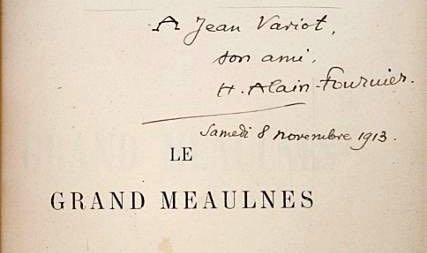
— — — —

— Afterzine 1. Edited by Hamish Robertson. [Brown Griffin, 2010]. Nicely conceived ’zine with a wide range of contributions. The stylish cover and the interpretations of negative space sparked my initial interest, and then I found a section entitled 10 Spines, book spines selected by Jessica Pigza of the New York Public Library. Her comments are intriguing but several of the photographs in this section (and elsewhere) are too murky for best effect.
— Lord Dunsany. Up in the Hills . William Heinemann, [1935]. Reread. Notable for treating the Troubles as Irish village farce, “ the army that’s up in the hills ”. And for passages such as this description of a cattle herd :
. . . for somehow he looked for wonders : all the stories he heard or told were of wonderful things ; fairies, witches, banshees and little people ; his world was full of wonders, sensible wonders ; while from the noisy world beyond him, the world of towns, there sometimes came crazy wonders, such as a motor car hooting past the white-washed cottages of Cranogue. And so it was that when he saw the archaeologists digging, he wondered without surprise.
— Emily Bax. Miss Bax of the Embassy . Houghton Mifflin, 1939. Memoir of the first female typewriter (clerk typist) of the American embassy in London, from Edwardian days up to the early years of the first world war. A charming window into a vanished world. Miss Bax describing the origins of the ugly American, circa 1902 : “ my first ‘ hot potato ’ . . . I mean a man who believes himself to be extremely important in the U.S. — whether he is or not — and who, when he is abroad, expects to be treated by the diplomats as though he were. ”
— Erin Kissane. The Elements of Content Strategy . [Foreword by Kristina Halvorson]. [A Book Apart, 2011]. Succinct and clearly expounded guided to thinking about the structure of the content of a website particularly as part of a larger endeavor. I fear the Endless Bookshelf will take some considerable time before implementing any of this book’s useful suggestions.
— — — —

— John Tingey. The Englishman Who Posted Himself and Other Curious Objects . Princeton Architectural Press, [2010]. Abundantly illustrated account of Reginald Bray (1879-1939), who about 1898 began to send unusual card and objects through the British postal system, including the crochet card above. He also sent cards to odd, challenging addresses (sometimes in the form of a rebus) with instructions to return them back to him, signed. He became the self-described Autograph King during the 1920s and 1930s. There seems to be no link with the postwar network of mail artists, such as Ray Johnson (whom Tingey mentions in passing) ; Bray seemed more concerned with collecting the artefacts than with connectivity or how, in William S. Wilson’s wonderful phrase, “ Ray Johnson, loving sets in motion, appreciated that loving sets in motion ”.
— William S. Wilson. “ With Ray: The Art of Friendship ”, in Black Mountain College Dossiers No. 4. Ray Johnson , 1997. Still the best single overview of the life and work of Ray Johnson, founder of the New York School of Correspondance (sic). In this remarkable essay, Wilson cites the useful Wittgensteinian dictum:
“ Never stay up on the barren heights of cleverness, but come down into the green valleys of silliness ” — Ludwig Wittgenstein to himself
— — — —
Current reading :
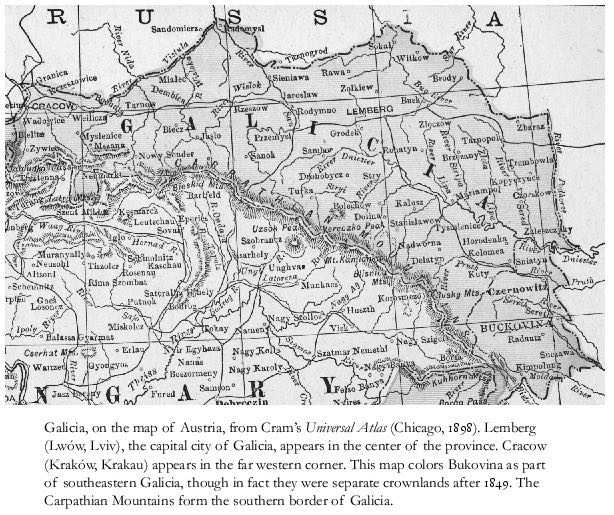
— Larry Wolff. The Idea of Galicia. History and Fantasy in Habsburg Political Culture . Stanford University Press, 2010. Galicia, an eastern European administrative region of the Habsburg empire, dissolved after 1918. Galicia “ had vanished from the map of Europe and was again evocative of loss & longing, a homeland preserved only in memory ”. The region, with its diverse histories and ethnicities, seems a cognate of Avram Davidson’s Scythia-Pannonia-Transbalkania in the Eszterhazy stories. I look forward to diving into this book.
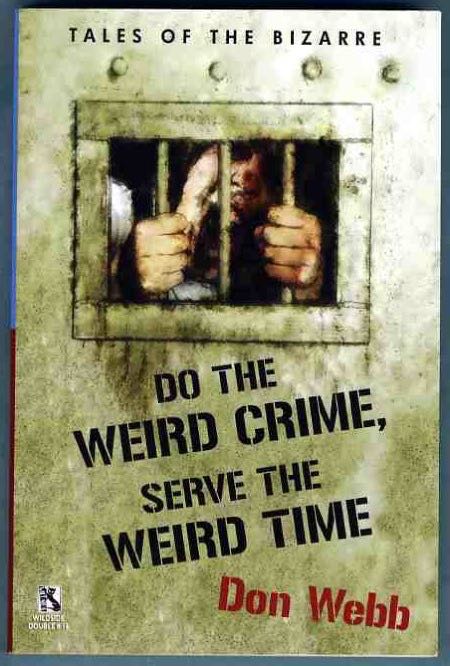
— Don Webb. Do the Weird Crime, Serve the Weird Time. Tales of the Bizarre . The Borgo Press, 2011 [bound tête-beche with :] Gary Lovisi. Gargoyle Nights. A Collection of Horror [Wildside Double # 16]. 143 ; 79 pp. Presentation copy, inscribed by the author.
A hand bound book
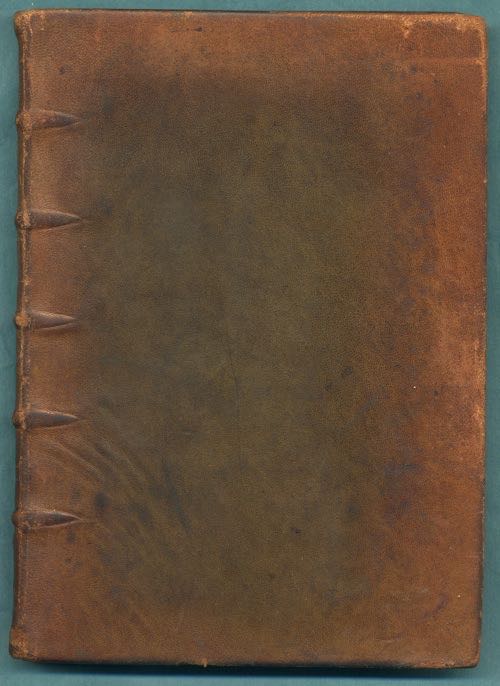
—Adolf Schmitthenner. Das Tagebuch meines Urgro▀vaters . J. Bielefelds Verlag, Freiburg (Baden), 1908. Presentation copy from the widow of the editor, “ Bertha Rossmassler von Aline Schmitthenner 1908 ”, bound in arts and crafts style by her daughter, Selma Louise Rossmässler, 1920. Diary of Philip Jacob Herbst, 1746-1805, also the great great grandfather of the recipient (the binder was your correspondent’s grandmother).
What criticism is
“ une analyse de texte argumentée qui sache séparer un livre du bruit qu’il fait et ignore l’image sociale de l’écrivain ”
Pierre Assouline, on the real importance of critical writing, in an
essay on the supposed death of criticism, from the république
des livres : an extended textual analysis which distinguishes
between the book and the noise it makes and which ignores the social
image of the writer. [ Wow ! ]
http://passouline.blog.lemonde.fr/2011/03/15/funerailles-annoncees-du-critique-olympien/
Bookshelves
The TLS for 25 February arrived two-and-a-half weeks late but contained a snappy poem by Alison Brackenbury, “ Last, the Bookcase ” : “ . . . The books of the dead | are crackling with life. ”
— — — —
From the Long Now blog, this picture of vast shelves, a library concept : vertical, beautiful ; not very Borgesian. [via Paul McAuley, http://unlikelyworlds.blogspot.com/]
The next regular update of the Endless Bookshelf will be posted on 27 April.
Your correspondent will be at the New York Antiquarian Book Fair, booth E5 (James Cummins Bookseller), at the Park Avenue Armory (67th & Park), 7-10 April. I do have some day passes available, please let me know if you would like one.
— — — —
A regular correspondent of the Endless Bookshelf writes :
Maurice Beresford, in The Lost Villages of England (1954), notes that when Parson Dennis of the depopulated Bluestone Heath, Lincolnshire, died in May, 1621, “ his cheeses were three times as valuable as his books. ” Good cheese, poor books, or sound priorities ? [MLV]
‘ a language of the mermaids ’
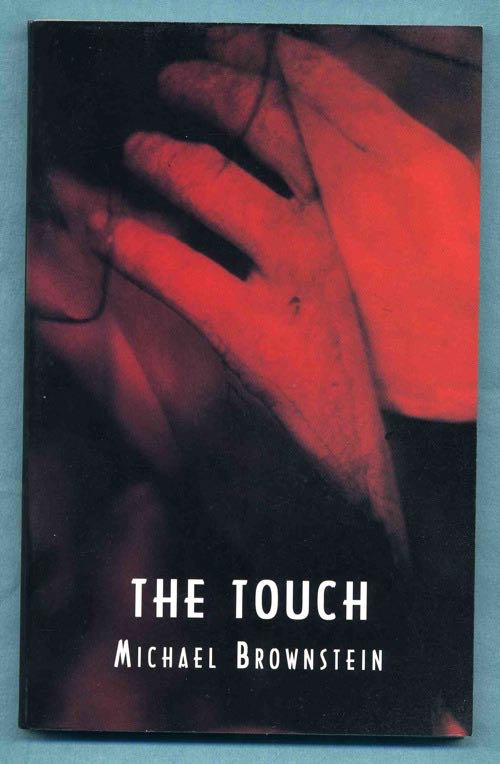
“ Her body quivered as she spoke, quickly lapsing into a language of the mermaids, singsong and unintelligible. ”
— Michael Brownstein. The Touch . Autonomedia,
[1993]. 123, [5] pp. Cover art by Kiki Smith.
The Touch is one of the favorite
books of the Endless Bookshelf. It is a shocking and compelling
tale of sex and excess that makes some readers profoundly uncomfortable ;
it is also a brilliant chronicle of an inner journey. Your correspondent
broadcast author Michael Brownstein reading the novel in its entirety
on the radio program Composed on the Tongue (WKCR-FM) before publication,
so these paragraphs do not pretend to any objectivity. I have given
away dozens of copies of the book * ; I
once wrote an essay on the novel that Andrei Codrescu rejected
for Exquisite Corpse as merely an extended blurb :
hence unnecessary since he had himself blurbed it, “ A
joint communiqué from Hermann Hesse and the Marquis de Sade
concerning AIDS and the New Age. An apocalyptic precision that’s
daunting. ” (from the back cover). That earlier essay
does not survive ; this note does not attempt to recreate it but
gathers thoughts shaped over a couple of decades.
The Touch is the story of a hapless, unnamed arts administrator at the end of his rope who wanders into the Transformational Institute. He leaves his previous life behind — even the name “ Sam ” is given him by one of the other disciples — and thrusts himself into the sexually charged “ work ” of the institute : a libertine, transgressive renunciation of the exterior world inside a well-appointed Manhattan townhouse. Brownstein paints a sinister, even threatening portrait of the cult of the Transformational Institute and its leaders, Richard and Diana, who have transformed themselves into dazzling, charismatic predators. What has been remarkable over the years is how many readers have assured me that this is the story of such and such a group, each one citing a different authentic incident. Sam races through the stages of excess, shocking even Richard with his boldness ; Richard imprisons Sam in isolation in a soundproof cage on the roof of the townhouse, known as “ heaven ”.
The prose is so clear and the narrative so deadpan serious in its catalogue of sudden couplings that the dark humor might almost be overlooked, but the novel is also a pitch perfect satire of cults and seekers and New York life in the late 1980s. The catchphrase “ sleek for life ”, for example, is hilarious. Satire, like nightmare, is most effective when it is closest to truth. The “ one on ones ”, Sam’s meetings with Richard, and the “ memory theater ” scenes are provocative, beautifully written expositions of inner landscapes, and decidedly ambiguous. Are these incidents illusory ? In The Power of Nothingness (1982), Janwillem van de Wetering’s translation of a 1954 novel by Alexandra David-Neel and Lama Yongden, when the novice is told to “ look at the wall ”, after three days he hallucinates an entire world of miniature paintings on the whitewashed walls of his room. Brownstein’s chronicle refuses such a simple explanation.
Something truly wonderful happens in the final chapter of The Touch , an extended sequence that has always made me value the book. In the work of J.G. Ballard, journeys into inner space seem to unleash a primal savagery (I’m thinking of the story where the protagonist leaves his car idling at the sidewalk and retreats into a feral lifestyle within his suburban house) but something else entirely is going in The Touch . Sam passes through every possible emotional state within the confines of the white room, and experiences another, self-created round of memory theater that is liberating. Brownstein’s prose reaches a transcendent equanimity that seems fully earned.
What seemed solid was really diaphonous, billowing out of reach. He couldn’t tell inside from outside any more, the inside of his body from what lay beyond his skin, but also the world outside from what went on inside his head. And past from present. [. . .] All inside and out at the same time. [. . .] His consciousness, his identity, his hopes and fears — all were temporary, provisional, lasting for moments in one single day, like the clouds. (120-1).
A book is an illusory construct, a thought experiment in which the author employs language so that a succession of images and ideas appears before the reader : clearly perceived yet void of substance. One of those rare, genuine books, The Touch is a mirror.
During a recent trip to California, your correspondent paid a visit to Serendipity Books in Berkeley, on the day of the biennial open house, and spent a couple of hours in the labyrinthine rooms and crowded shelves of the finest book shop in America. During the visit I encountered [DVS], loyal reader of the Endless Bookshelf, and other friends from all over the country and from England. After an hour and a half, I knew that somewhere in Serendipity there would be a shelf with early works by Michael Brownstein, and yes, this was the case and I made my way to it unassisted. I found early books I had only known as titles, and Peter Howard recounted their provenance while I chatted with him before heading out to Bolinas. Serendipity is a great book shop ; when it closes I do not know if its like will ever be seen again.
I found almost all of Michael Brownstein’s earliest work, as well as extra copies of The Touch :
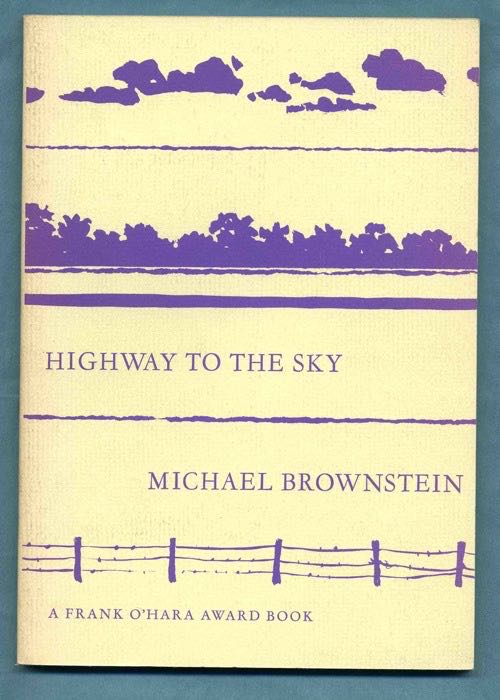
— Highway to the Sky . Frank O’Hara
Foundation at Columbia University Press, 1969.
— Brainstorms . Bobbs-Merrill, [1971].
— 30 Pictures . [Stinson Beach] : Grape Press,
1972.
— Strange Days Ahead . Calais, Vermont :
Z Press, 1975.
— When Nobody’s Looking . Rocky Ledge, Cottage
Editions, [1981]

This cache of Brownstein from Serendipity prompted me to put together the note about The Touch . I had long known his novels Country Cousins and Self-Reliance , and his superb collection of stories, Music from the Evening of the World (1988). It is always interesting to read early work of a poet and novelist, for it often contains in seed form the concerns of later writings. Brownstein’s most recent book World on Fire (2002), articulates an ecological vision not wholly unrelated to “ The Plot to Save the World ”, a story from Brainstorms included in the anthology The Ruins of Earth , edited by Tom Disch (1971).
Recent reading :
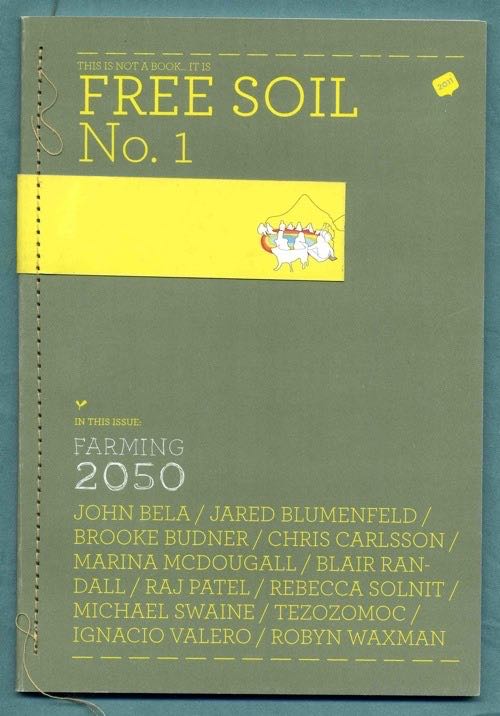
— Free Soil No. 1 … Farming 2050 , ed. Amy Franceschini, 2011. Essays and reflections upon the reintegration of agriculture into the urban world of the twenty-first century, from futurefarmers.com . Blair Randall’s piece in Free Soil, “ Cooperative Extension Agents ” is a clearly articulated re-imagining of the farming partnership between city and countryside :
[. . .] people ask, “ how much food can you grow in an urban area ? ” But I think that is the wrong question, a question that comes from an American idea of independence and complete self-sufficiency rather than a more generative idea of cooperation and collaboration.
Editor Amy Franceschini was on hand for the Weedwalk biennial gathering : BookWalk III, on Sunday 13 February. Orchestrated by Arcangelo Wessells and Michael Swaine, the Weedwalk drew a record crowd and spent a couple of hours walking through the Mission district and considering opportunistic plants in a very urban setting.
— Alexander and Nicholas Humez. Latina pro Populo. Latin for People . Little, Brown and Company, [1976]. Introductory text, written with excellent sense of humor, an interesting chapter on “ The Logic of the Talking Bear ” and a broad enough remit to discuss, succinctly and grammatically, the status of women in Rome : “ Thus, Publia Duodecima would have been the unhappy twelfth daughter of some prolific male of the gens Publius. To this, a Roman female could add the genitive form of her husband’s name. ” In a recent essay in the New York Review of Science Fiction , David Drake observes, “ The Romans in many ways treated women better than the ancient Greeks did. (Women in Pathan villages today are treated as well as the women of classical Athens.) Nonetheless, if you’re mentally equating Roman women with women in Victorian England (let alone women in modern America), you do not understand Rome. ” Gift of [EG].
— Bradford Morrow. The Diviner’s Tale . Otto Penzler, Houghton Mifflin Harcourt, 2011.
— Jeff Smith. Bone . Cartoon Books, 2004. A mammoth paperback compendium. A tale of epic proportions (pp. 1332 + map) that opens with deceptive simplicity, and complex allusion to earlier literatures ; after a few sections it becomes clear that Pogo has wandered from the small town swamp into Fantasyland.
— Matt Ruff. The Mirage (forthcoming, 2012). An awesome novel of alternate reality, which prompted me to read his earlier published books, Bad Monkeys (2007) and Sewer, Gas & Electric. The Public Works Trilogy (1997 ; 2004 paperback). The satire of Randians in Sewer, Gas & Electric is hilarious, intensely detailed and internally consistent.
— Francisco Goya y Lucientes. Los Caprichos, (1799). A lovely copy of the first edition in a contemporary binding passed across my desk for a time, and so I invited Michael Swanwick and the board of the M.C. Porter Foundation of the Humanities to examine it and then join me for lunch.
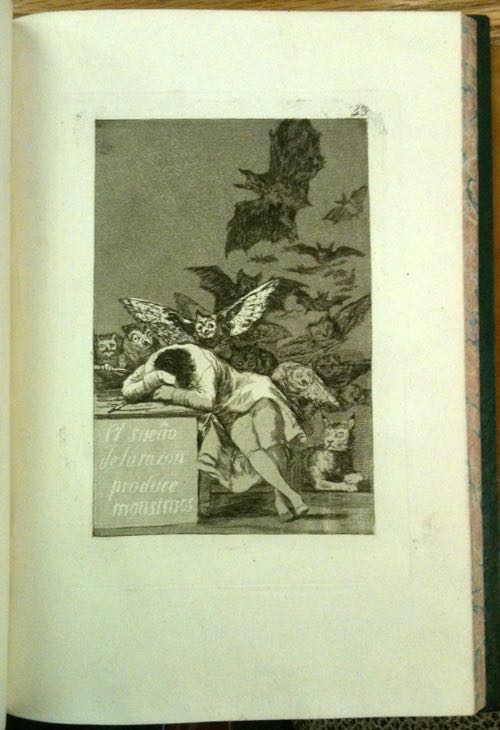
No. 43, El sueño de la razon produce monstruos
Barry Humphries’ Five Books
Barry Humphries (aka Dame Edna) interviewed by Mariella Frostrup on the Open Book, about 5 favorite books on the BBC (26 December 2010), a fine conversation and some astonishing choices :
http://www.bbc.co.uk/iplayer/console/b00wr4j9/Open_Book_26_12_2010
Current link for download : https://www.bbc.co.uk/programmes/p02shcq5
Norman Douglas. South Wind (1917) : “ funny ”
Joseph Roth. The Radetzky March : “ most serious book ”
Matthew Lewis. The Monk (1796) : “ naughty ”
Osbert Sitwell. [Autobiography], 5 vols. (1944-1950) : “ most entertaining ”
Vol. 1, Left Hand, Right Hand! ; Vol. 2, The Scarlet Tree ;
Vol. 3, Great Morning ; Vol. 4, Laughter in the Room ;
Vol. 5, Noble Essences: Or Courteous Revelations
John Betjeman. [Poems] : “ touching and true ”
The next title from Temporary Culture
MY MAN & OTHER CRITICAL FICTIONS by WENDY WALKER
Publication date : October 2011
Original frontispiece illustration. 128 pp. Oblong 6-1/2 x 9-1/2 inches.
Twenty numbered copies will be specially bound by hand for subscribers and
signed by the author and artist (details upon request).
Trade issue : hardcover, full cloth binding with printed dust jacket.
$22.50
ISBN 978-0-9764660-7-9
[Updated link] Details at :
https://temporary-culture.com/books/my-man-and-other-critical-fictions-2/#310017
MY MAN is an original collection of 8 critical fictions on Joseph Conrad’s Nostromo, King
Lear, Olaudah Equiano, Harry Mathews, and other writers and texts. The
critical fiction is a literary mode that takes as its subject another literary
work and treats of that work’s construction, obsessions, and sources
in narrative and poetic, rather than expository/critical terms. Wendy Walker
is one of the chief proponents of the critical fiction today ; some
of her predecessors include Jean Rhys, Jorge Luis Borges, Angela Carter,
and Guy Davenport.
Wendy Walker is author of a modern masterpiece, The Secret Service (1992) ;
a work of poetic non-fiction, Blue Fire (Proteotypes, 2009),
exploring the case of Constance Kent ; and two collections of short
fiction, The Sea-Rabbit, or, The Artist of Life (1988) and Stories
out of Omarie (1995). Her website is wendywalker.com.
To celebrate publication of MY MAN & OTHER CRITICAL FICTIONS, Temporary Culture is pleased to convene a Critical Fiction Symposium on Tuesday 25 October 2011 at the Grolier Club in New York City. Participants will include Wendy Walker, Ron Janssen, John Crowley, Henry Wessells, and others. Full details will be announced in early March.
27-30 January 2011
[ read more ; with a link to pdf file of story ]
WHAT HAPPENED TO THE LANDS OF THE VALLEY
No one knows when it began. It is no longer possible
to narrow it down to a particular year or a specific date, but many
of us remember the feelings of anxiety that grew inside after the promulgation
of the Second Series of Executive Decrees. These granted to “ outsiders ” the
right to own land in Egypt. Voices were raised in protest. Every newspaper
published countless editorials against the Decrees, each paper with
its own particular slant. Conferences were held, and political cartoons
appeared. Short films on the controversy played in movie houses before
feature films. Skeptics and resistance organizers were beaten up.
So many other things happened at the time when
our lands were sold from under us, and all the documents from these years have
been destroyed. Facts and truth disappeared when circulars and publications from
our past were later edited and altered to conform with the official version of
events.
[ read more ; with a link to pdf file of the story ]
Translator’s note : ‘ What Happened to the Lands of the Valley ’ was first published in the collection Dhikr Ma Jara (Remembering what happened) by Gamal al-Ghitani [Cairo, Capitol Printers for Madbuli Bookshop, 1978]. I first read this story in Cairo in 1983, and it stuck with me. In 1986 I wrote to the author from Philadelphia and received his permission to translate the tale. The formal aspects of the story challenged editors of journals to which I proposed it ; at one point I intended to publish it as part of the eighth issue of the ’zine Temporary Culture (still unpublished). What remains astonishing and compelling about ‘ What Happened to the Lands of the Valley ’ is that in 1975, before anyone else, Gamal al-Ghitani foresaw the human consequences of the infitah , the opening of Egypt to the free market, and the impact on Egyptian domestic life of what is now called globalization. That brilliant insight, and the unflinching humanity of the story, are what make this story irresistible to me.
— Henry Wessells
Copyright © 1978, 2011 by GAMAL AL-GHITANI
Translation copyright © 2011 by TEMPORARY CULTURE
This electronic edition may be freely distributed in unaltered form for non-commercial purposes. All other rights of the translator reserved.
Current reading :
Charles Brockden Brown. Wieland ; or, the Transformation. [An American Tale]. Together with Memoirs of Carwin the Biloquist. A Fragment . Edited and with an introduction by Fred Lewis Pattee. 1798 ; Harcourt Brace & World, Harbinger paperback, [copyright 1926].
A challenging, fascinating book, the first American literary response to Godwin’s novel and political ideals. The ‘ Carwin ’ fragment contains some intriguing passages that seem to spring direct from the preoccupations of Brown’s Alcuin (1797), “ the duty of unfettering our minds from the prejudices which govern the world ” and the very Godwinian notion of humans as susceptible of “endless improvement ” under favorable circumstances. And Brown’s description of an antiquary keen to know “what pendragon or druid it was who set up the first stone on Salisbury plain ” gives a notion that is a worthy addition to Sir Thomas Browne’s list of “puzzling questions ”, “ What song the Sirens sang, or what name Ulysses assumed when he hid himself among women . . . ” (see next item).
Recent reading :
— Robert Irwin. Camel (Reaktion Books, [2010]). A quirky, fun book, full of erudition & nice pictures. “ This is my first book in which scientific matters are at issue. I am startled to find how much contention, vagueness and sheer lack of research devils the scientific study of the camel. [. . .] I fear that the lived experience of the camel is beyond our ability to conjecture. It is certainly beyond mine. As Ludwig Wittgenstein observed, ‘ If a lion could speak, we would not understand him. ’ ” Irwin’s text breathes with his eagerness to convey interesting information.
— Samuel L. Clemens. 1601 and Is Shakespeare Dead ? Introduction by Erica Jong, afterword by Leslie Fiedler.Oxford Mark Twain, edited by Shelley Fisher Fishkin. Oxford University Press, 1996. How Victorian are you ? Read Saml Clemens’ 1601 [written 1876, printed 1880, 1882, etc.] and find out.
— Wendy Walker. The Secret Service. Sun & Moon Classics, 1992. A favorite, re-read for the first time in several years, with pleasure :
“ ‘ I have never had an answer to a question before now, if that woman has given me an answer. ’ ”
— Graham Greene. Our Man in Havana (1958 ; Penguin Classics paperback). “ Reality in our century is not something to be faced ” says the character Dr. Hasselbacher. Hilarious and bleak.
— Peter Straub. The Throat (1993 ; Anchor paperback, 2010)
— Peter Straub. The Hellfire Club (Random House, 1996). A gripping book, with a fascinating imaginary book at the novel’s heart : Night Journey by Hugo Driver.
“ You’re talking about the times when the same things happen all over again after they happened the first time, but differently, so the real meaning comes out. And the other thing you’re talking about is when anyone with half a brain can see what’s going to happen, so there’s no point in writing it all down [. . .] It’s a novel, not journalism. ”
— Nicolas Freeling. Love in Amsterdam (1962 ; Penguin paperback, 1965) [browned & collapsing as as I turned the pages].
‘ Attitude is every thing ! ’

— [CLAY, Edward W.]. Lessons in Dancing, Exemplified by
Sketches from Real Life in the City of Philadelphia, by a Dilettante.
[Cover title]. Title from printed wrapper. 8 hand-colored plates of
dancing couples, with printed captions.
A rare little book, not in any of the usual locations, but not unique :
one other copy is presumed to exist. Found one day, sold the next, soon to
be in a public collection [images reduced]

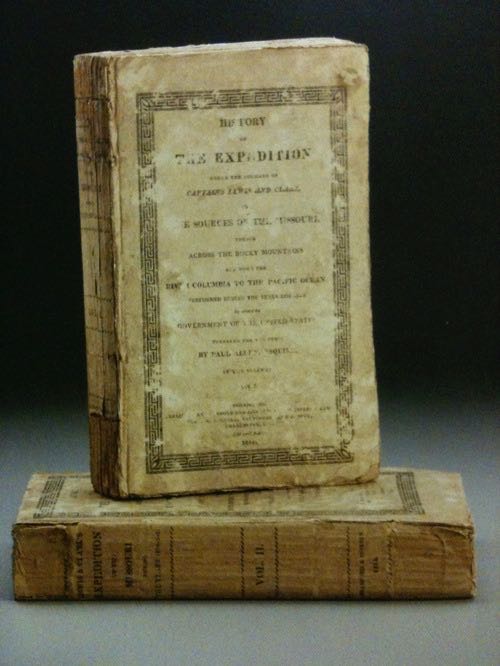
— Stephen Weissman. Printed Americana in the Harlan
Crow Library. A first progress report. With an annotated checklist
of 250 Books, Pamphlets, and Broadsides . Dallas, 2010
— Joe Rubinfine and Ryan Lord. Exceptional Manuscripts in the Harlan
Crow Library . Dallas, 2010
These two handsome volumes arrived courtesy of my friend Sam Fore, scholar of Georgia in the revolutionary period, and librarian of the Crow Library. The “ progress report ” of printed Americana is a chronological log of material from the first printed Letter of Christopher Columbus (1493) to key works on religious tolerance and freedom of speech in colonial and revolutionary times, through the report of the Lewis and Clark expedition (uncut in original printed boards, 1814), to Henry Adams’ own copy of The Education of Henry Adams (1907). Many of the pre-1750 imprints are known in only a few copies, and it is quite astonishing to know that collections can still be formed.

Imaginative literature, too, had a place in early America : The History of the Kingdom of Basaruah (1715), a north American allegory on the model of Bunyan’s Pilgrim’s Progress , was written by Joseph Morgan in Freehold, New Jersey.
Reading through such a catalogue is an intellectually stimulating experience : to learn that a dissenting view of the Salem witch trials of the 1690s was unpublishable in Puritan Cambridge when written in 1697, and that when the book finally arrived from London it was publicly burned.
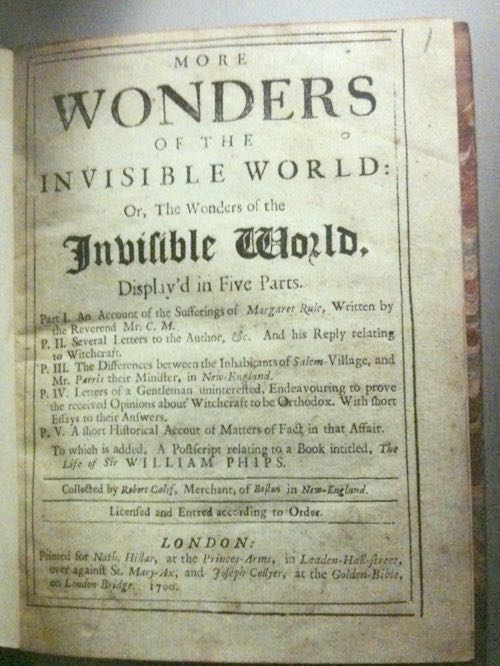
California Antiquarian Book Fair
Your correspondent will be in San Francisco for the 44th California International Antiquarian Book Fair, to be held 11-13 February at the Concourse Center. Come say hello at Booth 419 (James Cummins Bookseller). Passes are available if you send a note in advance.
There will likely also be a Weedwalk / Book Walk on Sunday morning 13 February : details will be added as they are known.
— — — —
Your correspondent was in the Seattle Public Library at the beginning of January and found the building to be a surprise and a delight, both the Dewey Decimal spiral of the open stacks and the Seattle Room on level 10, where I had my portrait taken in The Silva of North America :
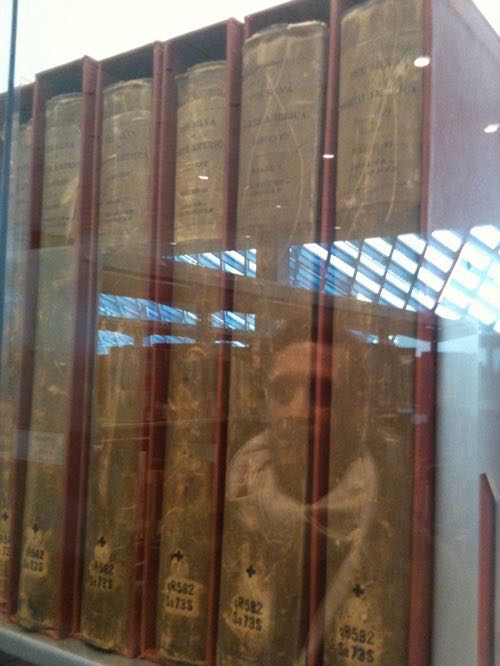
and where a title caught my eye :

This is a unique manuscript book in the Central Library Seattle Collection : A String of Brass Beads by Walter Shelley Phillips, 1917. I should like to return to the library and read the book.
27 December 10
Very Few Letters
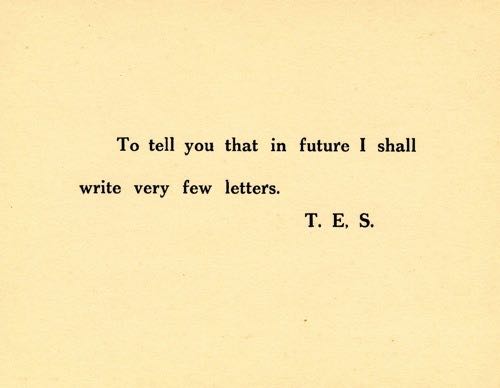
— [T. E. Lawrence]. To tell you that in future I shall write very few letters. T. E. S. Printed card, [February 1935], sent by Lawrence to his correspondents in early 1935. O’Brien A161. An uncommon piece of ephemera.
Effective with this post the Endless Bookshelf will adopt a new, monthly schedule for updates. The next sections of the Endless Bookshelf will appear on 27 January 2011.
Marginal notes about current and recent reading will still continue to appear in the interval. Readers are especially encouraged to send lists of The Last Three (books read), which now cumulates here.(And if you are looking for suggestions for reading, The Last Three is as eclectic and erudite as any list you will find.)
Your correspondent has a few writing assignments to complete over the next several months that will reduce the amount of time available to produce the Endless Bookshelf.
Thank you for your regular attention to these columns over the past four years. Please walk through the archives and continue to send comments and suggestions. Happy new year ! [HWW]
This creaking and constantly evolving website of the endless bookshelf : I expect that some entries will be brief, others will take the form of more elaborate essays, and eventually I will become adept at incorporating comments or interactivity. Right now you’ll have to send links to me, dear readers. [HWW]
electronym : wessells
at aol dot com
Copyright © 2007-2011
Henry
Wessells and individual contributors.
Produced by Temporary
Culture, P.O.B. 43072, Upper Montclair, NJ 07043 USA.
